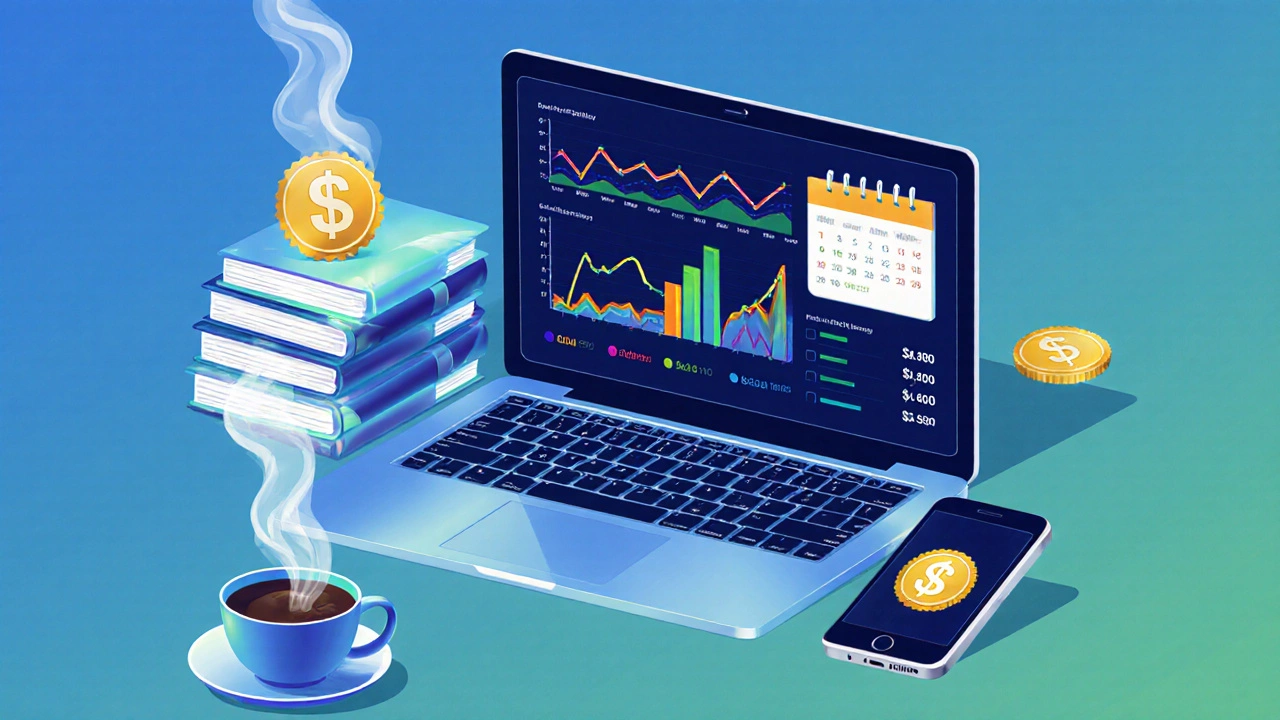Blogger Earnings Calculator
Calculate Your Monthly Earnings
Estimated Monthly Earnings
These estimates are based on industry averages from the article. Actual earnings may vary based on your niche, traffic quality, and content engagement.
Pro Tip: Combine multiple monetization methods to maximize your earnings potential.
Ever wondered whether the free platform Blogger is actually a money‑making machine or just a hobby‑space? The short answer is yes-many creators turn a hobby blog into a steady income stream. But the path isn’t a single‑click miracle; it’s a mix of ad networks, affiliate links, sponsored deals and sometimes even selling your own products. Below we break down every realistic way to earn on Blogger, the numbers you can expect, and the common traps that keep most users from seeing a payday.
What is Blogger and Why It Still Matters
Blogger is a free blogging platform launched by Google in 1999. It lets anyone create a blog with a Google account, offers built‑in hosting, and integrates seamlessly with other Google services like Drive, Analytics and, most importantly, Google AdSense. Because it’s free, the barrier to entry is low, making it a popular first step for writers, photographers, and niche hobbyists.
Primary Ways to Monetize a Blogger Site
- Google AdSense - Display ads served by Google’s network.
- Affiliate Marketing - Earn a commission when readers click your links and buy.
- Sponsored Posts - Brands pay you to write about their product.
- Direct ad sales - You sell banner space to companies directly.
- Content‑related products - E‑books, courses, or printables sold to your audience.
Each method has its own set‑up steps, payout schedules, and income potential. Let’s dig into the most common - AdSense - before looking at the others.
Google AdSense: The Backbone of Blogger Earnings
Google AdSense is Google’s advertising platform that matches ads to the content of your site and the interests of your visitors. When a visitor clicks an ad, you earn a share of the cost‑per‑click (CPC). For Blogger users the integration is almost automatic - just enable AdSense in the dashboard and choose where the ads appear.
Eligibility: Your blog must have at least 100 unique visitors per day, comply with Google’s content policies, and have a valid Google account. Once approved, you’ll see ads after a short review period (usually 48‑72 hours).
Payout threshold: Google pays out once you reach $100. Payment methods include direct bank transfer, wire, or check, and they happen on the 21st of each month provided you’ve met the threshold.
Typical earnings: CPM (cost per thousand impressions) rates vary widely by niche, geography and ad placement. In 2024 average CPMs on Blogger ranged from $0.50 in low‑competition lifestyle blogs to $8.00 in finance‑focused sites. Click‑through rates (CTR) hover around 0.5‑1.2% for most blogs.
Real‑world example: A travel blog with 30k monthly pageviews in 2023 earned roughly $180 from AdSense (average CPM $2.40, CTR 0.9%). A tech review blog with 80k pageviews earned $720 (average CPM $5.90, CTR 1.5%).
Affiliate Marketing on Blogger
Affiliate programs let you place unique links to products; when a reader buys through that link, you collect a commission. The most popular for Blogger users is Amazon Associates, but there are thousands of niche networks (e.g., ShareASale, Commission Junction, Rakuten).
How it works:
- Join an affiliate program (free, instant approval for most).
- Generate a tracking link for a product you recommend.
- Embed the link inside a blog post, product review, or “best‑of” list.
- Earn a commission (usually 4‑10% for physical goods, up to 50% for digital products).
Example: A cooking blog that posted a “Top 5 Blender Reviews” with Amazon links earned $45 in a month from 150 clicks, assuming an average conversion rate of 3% and a 5% commission on $300 average order value.
Sponsored Posts and Brand Collaborations
Brands often look for niche blogs with engaged audiences. A sponsored post is simply a paid article that promotes a product, service, or campaign. Rates vary from $50 for a micro‑blog with 5k monthly visitors to $500+ for a well‑ranked authority site.
Key steps to secure sponsorships:
- Build a media kit - include traffic stats, audience demographics, and previous collaborations.
- Reach out to brands or join influencer platforms like IZEA or AspireIQ.
- Negotiate deliverables (post length, social shares, review period) and price.
Tip: Always disclose sponsored content to stay compliant with FTC guidelines and maintain reader trust.
Direct Ad Sales and Ad Networks (Media.net, AdThrive)
When your traffic scales (usually >50k monthly pageviews), you can sell banner space directly for a flat fee or partner with premium ad networks. Two popular choices are Media.net and AdThrive. Both require higher traffic thresholds (Media.net ~10k, AdThrive ~100k) but offer higher CPMs (often $8‑$15) because they serve contextual ads from a wider pool of advertisers.
Direct sales give you full control over pricing and placement, but you’ll need a sales pitch and a simple invoice system.
Selling Digital Products or Services
Many successful Blogger owners turn their expertise into downloadable products: e‑books, printable planners, or video courses. Because the platform integrates with PayPal and Stripe, you can add a “Buy Now” button next to a post.
Typical revenue: An e‑book priced at $12 that sells 200 copies a month brings $2,400 before fees. Combine this with ad revenue and you have a diversified income stream.

Estimating Your Potential Blogger Earnings
| Monthly Pageviews | Avg. CPM (AdSense) | Affiliate Conversions | Sponsored Posts | Total Estimated Income |
|---|---|---|---|---|
| 5,000 | $1.20 | $30 | $50 | $110 |
| 20,000 | $2.40 | $120 | $150 | $510 |
| 50,000 | $5.00 | $350 | $400 | $1,200 |
| 100,000+ | $8.00 | $800 | $900 | $2,900+ |
These numbers are illustrative - your actual earnings depend on niche competitiveness, content quality, SEO performance, and how aggressively you implement multiple monetization streams.
Tips to Maximize Blogger Revenue
- Optimize ad placement: Above‑the‑fold, in‑post, and sidebar tend to get the highest CTR.
- Focus on SEO - target long‑tail keywords that attract targeted traffic (e.g., “best budget DSLR for travel blogging”).
- Write evergreen content that keeps generating traffic months after publishing.
- Use catchy calls‑to‑action for affiliate links (“Check price on Amazon”).
- Track performance with Google Analytics and AdSense reports; tweak low‑performing ads.
- Stay compliant: no prohibited content, proper disclosures, and avoid click‑bait.
Remember, the goal isn’t just to “get paid” but to build a sustainable brand. Combine several income sources, keep your audience’s trust, and the paycheck will follow.
Frequently Asked Questions
Can I earn money on Blogger without Google AdSense?
Yes. Affiliate links, sponsored posts, selling digital products, and direct ad sales are all viable alternatives. Many bloggers start with affiliate programs before qualifying for AdSense.
How long does it take to receive the first payment?
If you hit the $100 threshold, Google issues payment around the 21st of the following month. For affiliates, payout cycles vary - Amazon pays roughly every 60 days after a transaction closes.
Do I need to own a domain to monetize Blogger?
No. Blogger’s free sub‑domain (yourname.blogspot.com) works with AdSense and affiliate links. However, a custom domain looks more professional and can improve SEO.
What’s the typical CPM for a niche blog?
Niche CPMs can range from $0.70 for general lifestyle blogs to $12‑$15 for finance, insurance, or B2B technology blogs that attract high‑value advertisers.
Are there any hidden fees with AdSense?
AdSense deducts a small share of the advertiser’s bid (typically 32%) before paying you. There are no setup or monthly fees; you only pay when you earn.
